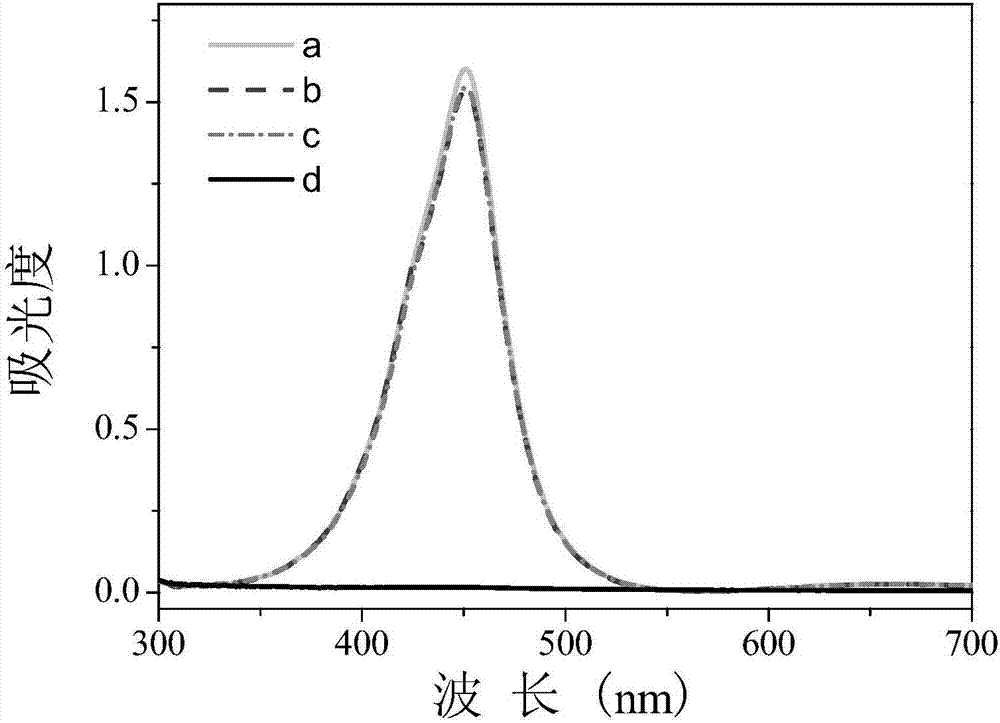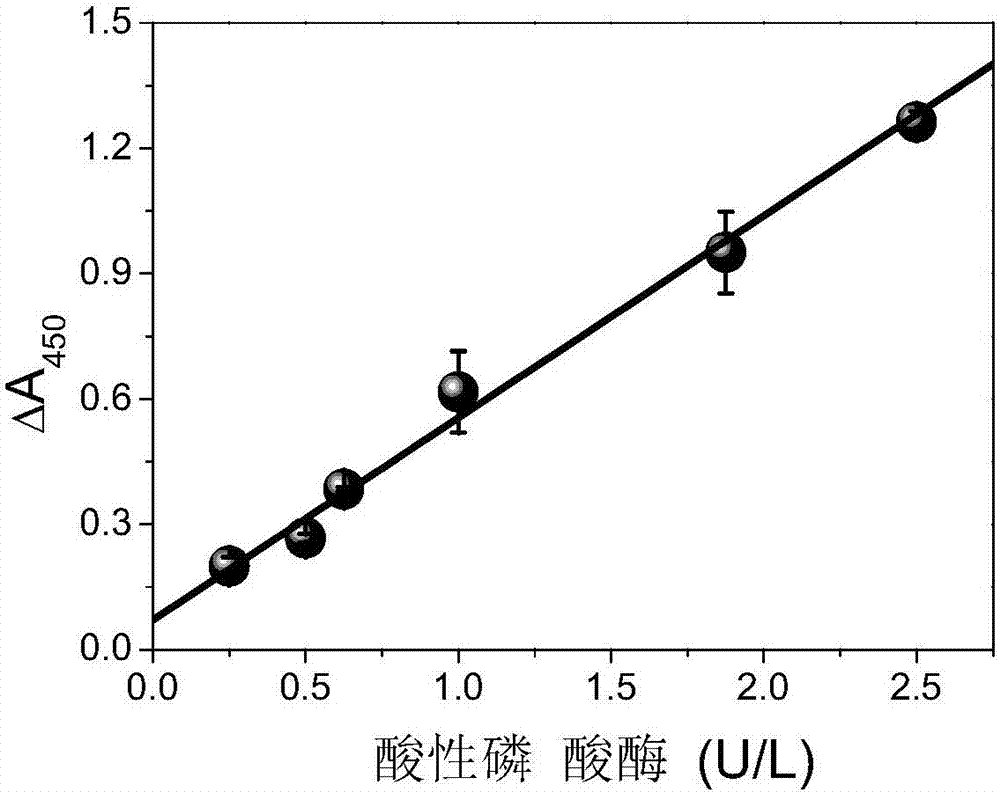Method for determining acid phosphatase based on chitosan-platinum simulated oxidase
A technology for acid phosphatase and its determination method, which is applied in the field of determination of acid phosphatase and its inhibitors, can solve the problems of inconspicuous color development of tetramethylbenzidine hydrochloride, etc., and achieve simple and fast preparation process and simple detection steps , the effect of low detection cost
- Summary
- Abstract
- Description
- Claims
- Application Information
AI Technical Summary
Problems solved by technology
Method used
Image
Examples
Embodiment 1
[0029] Weigh 0.1 g of chitosan and dissolve it in 50 mL of acetic acid with a concentration of 1% (v / v), and stir for 15 minutes to completely dissolve the chitosan to obtain a chitosan solution with a concentration of 0.2% (m / v). Add 2 mL of 10 mmol / L chloroplatinic acid to 47 mL of 0.2% (m / v) chitosan solution, stir for 30 minutes, and then add 1 mL of freshly prepared 0.2 mol / L chitosan solution dropwise. Sodium borohydride solution (completely added within 5 minutes), placed in the dark and stirred for 90 minutes to obtain a dark brown chitosan-platinum oxidase solution. Store the product in the dark and refrigerate. All glassware used in the above process was soaked in aqua regia, washed thoroughly with double distilled water, and dried.
Embodiment 2
[0031] Add 50 μL of ascorbyl phosphate with a concentration of 4 mmol / L and 50 μL of acid phosphatase with a concentration of 0.1 U / mL into 200 μL of acetate buffer (pH 5, 50 mmol / L), mix well and place in React at 37°C for 30 minutes. Add 632.5 μL acetate buffer (pH 5, 50 mmol / L), 50 μL 3,3’,5,5’-tetramethylbenzidine hydrochloride solution with a concentration of 3 mmol / L and 17.5 μL The chitosan-platinum simulated oxidase solution prepared in Example 1 was mixed evenly and then reacted at 37°C for 5 minutes, and 200 μL of sulfuric acid solution with a concentration of 2 mol / L was added to terminate the reaction, and the color change or Measure the UV-Vis absorption spectrum of the solution. When visually observing the color change, the solution color of the control group is dark yellow, and the solution color of the experimental group becomes colorless (see figure 1 ). When measuring the ultraviolet-visible absorption spectrum, the absorption spectrum of the control group...
Embodiment 3
[0033] Add 50 μL of ascorbyl phosphate with a concentration of 4 mmol / L and 50 μL of acid phosphatase of different concentrations into 200 μL of acetate buffer (pH 5, 50 mmol / L), mix well and react at 37°C for 30 minute. Add 632.5 μL acetate buffer (pH 5, 50 mmol / L), 50 μL 3,3’,5,5’-tetramethylbenzidine hydrochloride solution with a concentration of 3 mmol / L and 17.5 μL The chitosan-platinum simulated oxidase solution prepared in Example 1 was mixed evenly and then reacted at 37°C for 5 minutes, and 200 μL of sulfuric acid solution with a concentration of 2 mol / L was added to terminate the reaction, and the absorbance value A of the solution was measured. 450 . Depend on image 3 It can be seen that with the increase of acid phosphatase concentration, the absorbance value A 450 The change value (△A 450 ) gradually increases. In the range of 0.25 ~ 2.5U / L, △A 450 It has a linear relationship with the concentration of acid phosphatase, and the lowest detection limit is 0.0...
PUM
| Property | Measurement | Unit |
|---|---|---|
| recovery rate | aaaaa | aaaaa |
Abstract
Description
Claims
Application Information
 Login to View More
Login to View More - R&D
- Intellectual Property
- Life Sciences
- Materials
- Tech Scout
- Unparalleled Data Quality
- Higher Quality Content
- 60% Fewer Hallucinations
Browse by: Latest US Patents, China's latest patents, Technical Efficacy Thesaurus, Application Domain, Technology Topic, Popular Technical Reports.
© 2025 PatSnap. All rights reserved.Legal|Privacy policy|Modern Slavery Act Transparency Statement|Sitemap|About US| Contact US: help@patsnap.com



